And that is assuming everything goes to plan.
+52
lancelot
mnztr
TMA1
Scorpius
sepheronx
Podlodka77
wilhelm
caveat emptor
Swgman_BK
bac112
Krepost
Lennox
Autodestruct
Broski
limb
Backman
Arrow
tomazy
ALAMO
Russian_Patriot_
x_54_u43
Kiko
Rodion_Romanovic
KoTeMoRe
thegopnik
JohninMK
AJ-47
Isos
dino00
miketheterrible
william.boutros
flamming_python
medo
PhSt
marcellogo
Gazputin
LMFS
Hole
kvs
Cyberspec
higurashihougi
PapaDragon
George1
TheArmenian
magnumcromagnon
Austin
TR1
GarryB
Viktor
bhramos
Stealthflanker
Admin
56 posters
U.E.C.- Russian aircraft engines

TR1- Posts : 5435
Points : 5433
Join date : 2011-12-06
- Post n°26
 Re: U.E.C.- Russian aircraft engines
Re: U.E.C.- Russian aircraft engines
So he spells it out, no earlier than 2017 can they substitute helicopter engines from Ukraine.
And that is assuming everything goes to plan.
And that is assuming everything goes to plan.

George1- Posts : 18497
Points : 19000
Join date : 2011-12-22
Location : Greece
- Post n°27
 Re: U.E.C.- Russian aircraft engines
Re: U.E.C.- Russian aircraft engines
UEC has fulfilled its contract for MiG-29 fighter jet engines ahead of schedule

PapaDragon- Posts : 13456
Points : 13496
Join date : 2015-04-26
Location : Fort Evil, Serbia
- Post n°28
 Re: U.E.C.- Russian aircraft engines
Re: U.E.C.- Russian aircraft engines
Big article and lots of info on jet engines.

''The Resurrection of Russia's Aircraft Engine Industry''
http://russia-insider.com/en/technology/resurrection-russias-aircraft-engine-industry/ri9195
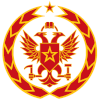
higurashihougi- Posts : 3377
Points : 3464
Join date : 2014-08-13
Location : A small and cutie S-shaped land.
- Post n°29
 Re: U.E.C.- Russian aircraft engines
Re: U.E.C.- Russian aircraft engines
PapaDragon wrote:
Big article and lots of info on jet engines.
''The Resurrection of Russia's Aircraft Engine Industry''
http://russia-insider.com/en/technology/resurrection-russias-aircraft-engine-industry/ri9195
Interesting article.
My vote as a thank.

magnumcromagnon- Posts : 8138
Points : 8273
Join date : 2013-12-05
Location : Pindos ave., Pindosville, Pindosylvania, Pindostan
- Post n°30
 Re: U.E.C.- Russian aircraft engines
Re: U.E.C.- Russian aircraft engines
Fantastic news! UEC created "detonation" engines, which are superior to air breathing engines.
1.) Detonating engines showed a 30-50% reduction in fuel consumption compared to air breathing engines.
2.) Thrust is increased by 1.5 - 2x that over air breathing engines.
3.) Detonating engine technology is incredibly flexible, and can be applied to drones, cruise missiles, rocket engines, subsonic and supersonic aircraft!
I wonder if this is related to the PAK-FA's engines not needing oxygen to start them up?
1.) Detonating engines showed a 30-50% reduction in fuel consumption compared to air breathing engines.
2.) Thrust is increased by 1.5 - 2x that over air breathing engines.
3.) Detonating engine technology is incredibly flexible, and can be applied to drones, cruise missiles, rocket engines, subsonic and supersonic aircraft!
UEC creates a new generation of engines for aircraft and missiles
The developments will be used detonation technology
United Engine Corporation (UEC) plans to soon begin building new aircraft and rocket engines, which will be used by the detonation technologies.
Technology demonstrator detonation of subsonic and supersonic engines have already been created. In tests, they showed a 30-50% better specific fuel consumption and cravings compared to the air-breathing, reports RIA "Novosti", citing data from the corporation. The included APC experimental design bureau. AM Cradles proposed the concept of a family of detonation engines for various purposes, including drones and cruise missiles, combined propulsion aerospace aircraft engines and space-rocket systems.
Detonation engines cover a wide range of speeds, which can be used to create hypersonic missile design which is actively conducted in Russia in recent years. To date, aircraft and rocket engines traditional schemes have practically exhausted the possibility of a significant improvement in their trailer-economic parameters. Therefore, in 2011 in Russia, work is underway to establish a pulse detonation propulsion. In 2013, the OKB. Cradles tested experienced reduced sample resonator pulsed detonation engine with two-stage combustion kerosinovozdushnoy mixture. In experiments performed repeatedly turning on and off of the new engine, as well as the regulation of traction. According to the design office, detonation engine thrust-planes will increase by 1.5-2 times.
http://rostec.ru/news/4517327
I wonder if this is related to the PAK-FA's engines not needing oxygen to start them up?
thegopnik likes this post

Cyberspec- Posts : 2904
Points : 3057
Join date : 2011-08-08
Location : Terra Australis
- Post n°31
 Re: U.E.C.- Russian aircraft engines
Re: U.E.C.- Russian aircraft engines
magnumcromagnon wrote:Fantastic news! UEC created "detonation" engines, which are superior to air breathing engines.
Great News

I'm guessing it's this sort of engine
https://en.wikipedia.org/wiki/Pulse_detonation_engine

magnumcromagnon- Posts : 8138
Points : 8273
Join date : 2013-12-05
Location : Pindos ave., Pindosville, Pindosylvania, Pindostan
- Post n°32
 Re: U.E.C.- Russian aircraft engines
Re: U.E.C.- Russian aircraft engines
Cyberspec wrote:magnumcromagnon wrote:Fantastic news! UEC created "detonation" engines, which are superior to air breathing engines.
Great News
I'm guessing it's this sort of engine
https://en.wikipedia.org/wiki/Pulse_detonation_engine
I'm not too knowledgeable about detonation engines. They speak about being superior to air-breathing engines...are they saying they won't need air intakes?
If that's the case than that should seriously improve a fighter aircraft's RCS, reduction of drag/aerodynamics, as well as increase the space for internal carriage bays for weapons on stealth aircraft, assuming if the air intakes could be discarded.

Guest- Guest
- Post n°33
 Re: U.E.C.- Russian aircraft engines
Re: U.E.C.- Russian aircraft engines
magnumcromagnon wrote:Cyberspec wrote:magnumcromagnon wrote:Fantastic news! UEC created "detonation" engines, which are superior to air breathing engines.
Great News
I'm guessing it's this sort of engine
https://en.wikipedia.org/wiki/Pulse_detonation_engine
I'm not too knowledgeable about detonation engines. They speak about being superior to air-breathing engines...are they saying they won't need air intakes?
If that's the case than that should seriously improve a fighter aircraft's RCS, reduction of drag/aerodynamics, as well increase the space for internal carriage bays for weapons on stealth aircraft, assuming if the air intakes could be discarded.
Ah no, oxigen is always needed for any kind of combustion, explosion is basically very, very fast oxidation, like couple billion times hastened iron rusting, this is abit plastic explanation and not completelly true but i am trying to make a point here
"Detonation engines would replace jet engines in airplanes and the gas turbines that run power plants and Navy ships. A set of rotating blades at the front of those engines compresses air, which is then mixed with fuel and combusted in a steady flame. That produces hot gases that do the work an engine is designed to do, whether it’s turning a propeller, propelling a jet, or spinning a generator to produce electricity.
Improving the efficiency of conventional jet engines has involved finding ways to increase air compression. But the cost and complexity of that approach is making it harder to realize improvements. Detonation engines offer another way to achieve high pressures. In a detonation engine, fuel combustion generates a shock wave that raises pressures to levels 10 times those inside a conventional engine. “It’s like an explosion or a bomb,” says Kazhikathra Kailasanath, a researcher at the Naval Research Laboratory in Washington, DC. “If you burn something in an open flame, the pressure stays the same as the surrounding pressure. The big difference with a detonation engine is going from that to a confined type of combustion, where the pressure goes up and the combustion occurs more rapidly.”
The most highly developed form of detonation engine, which has been in the works for many years, is the pulse detonation engine, the type GE is developing. Whereas combustion occurs continuously in a conventional jet engine, pulse detonation involves setting off a series of detonations—say, 60 to 100 per minute.
The Naval Research Laboratory has another idea. It involves the use of a specially designed doughnut-like combustion chamber. One explosion is set off with a spark in one part of the chamber. As the shock wave propagates out from that explosion, the researchers keep it going by feeding in a precise mixture of fuel and air ahead of it. A handful of research groups have tested small versions of the engine that burn hydrogen. And the Navy researchers recently published a paper that shows the idea can work with hydrocarbon fuels like the ones that would be used in a ship, at least in detailed computer simulations. An advantage of this approach is that it produces a constant stream of hot gases, which more closely resembles what’s seen in a conventional jet engine. It’s also simpler, in that there’s no need to engineer a system to create detonations at a high rate."
More if you are interested on: http://www.technologyreview.com/news/507421/exploding-engine-could-reduce-fuel-consumption/

GarryB- Posts : 40436
Points : 40936
Join date : 2010-03-30
Location : New Zealand
- Post n°34
 Re: U.E.C.- Russian aircraft engines
Re: U.E.C.- Russian aircraft engines
I suspect these engines are of a new type.
The traditional pulse detonation engine is rather old... in fact it is as old as the V1 cruise missile.
Very simply its engine looks like a ramjet... it is a hollow tube with an open front and rear end for air to flow through. A PD engine however has louvers like a venetian blind over the front air intake. To start the engine fuel goes into the main tube and is detonated... the blast blows the blinds to the front closed so the now contained explosion is directed out the rear of the tube providing a small push forward. When the pressure drops the front venetian blinds open and air is sucked in... fuel is added and detonated blowing the blinds shut and creating another push forward.
On the real engine the detonation speed will result in hundreds of pulses per second providing quite a bit of thrust.
the engine is very simple.
The problem is that I don't think that is what they are talking about.
During testing with rocket motors it was found that the initial ignition resulted in a significantly higher power thrust than when the motor stabilised and ran normally.
What I think they are talking about is changing the way the jet engine is fuelled so rather than smooth continuous burning of fuel in the combustion chamber, they are flicking the fuel on and off so instead of burning it is detonating generating more thrust.
they could as easily pump fuel and oxygen into the engine to get controlled detonations without an intake, but it would be much cheaper and much more efficient scooping air up as the aircraft flys along.
Of course if you make a pulse detonation scramjet engine that can accelerate to orbital speed once you leave the atmosphere the intake could be closed and onboard oxygen could be used to power the engine as a pulse detonation rocket engine outside the atmosphere too...
The traditional pulse detonation engine is rather old... in fact it is as old as the V1 cruise missile.
Very simply its engine looks like a ramjet... it is a hollow tube with an open front and rear end for air to flow through. A PD engine however has louvers like a venetian blind over the front air intake. To start the engine fuel goes into the main tube and is detonated... the blast blows the blinds to the front closed so the now contained explosion is directed out the rear of the tube providing a small push forward. When the pressure drops the front venetian blinds open and air is sucked in... fuel is added and detonated blowing the blinds shut and creating another push forward.
On the real engine the detonation speed will result in hundreds of pulses per second providing quite a bit of thrust.
the engine is very simple.
The problem is that I don't think that is what they are talking about.
During testing with rocket motors it was found that the initial ignition resulted in a significantly higher power thrust than when the motor stabilised and ran normally.
What I think they are talking about is changing the way the jet engine is fuelled so rather than smooth continuous burning of fuel in the combustion chamber, they are flicking the fuel on and off so instead of burning it is detonating generating more thrust.
I'm not too knowledgeable about detonation engines. They speak about being superior to air-breathing engines...are they saying they won't need air intakes?
they could as easily pump fuel and oxygen into the engine to get controlled detonations without an intake, but it would be much cheaper and much more efficient scooping air up as the aircraft flys along.
Of course if you make a pulse detonation scramjet engine that can accelerate to orbital speed once you leave the atmosphere the intake could be closed and onboard oxygen could be used to power the engine as a pulse detonation rocket engine outside the atmosphere too...

Cyberspec- Posts : 2904
Points : 3057
Join date : 2011-08-08
Location : Terra Australis
- Post n°35
 Re: U.E.C.- Russian aircraft engines
Re: U.E.C.- Russian aircraft engines
Salute started deliveries of the first sets of VK-2500 engines

 http://bmpd.livejournal.com/1565487.html
http://bmpd.livejournal.com/1565487.html


George1- Posts : 18497
Points : 19000
Join date : 2011-12-22
Location : Greece
- Post n°36
 Re: U.E.C.- Russian aircraft engines
Re: U.E.C.- Russian aircraft engines
Cyberspec wrote:Salute started deliveries of the first sets of VK-2500 engines
http://bmpd.livejournal.com/1565487.html
Nice "machines"...


George1- Posts : 18497
Points : 19000
Join date : 2011-12-22
Location : Greece
- Post n°37
 United Engine Corporation
United Engine Corporation
Russia to complete import substitution program for helicopter engines by 2019
Russian Aviaton » Tuesday April 25, 2017 18:53 MSK
The United Engine-Making Corporation, part of Russia’s state hi-tech conglomerate Rostec, plans to produce 130 VK-2500 helicopter engines this year and complete its import substitution program in 2019, Corporation CEO Alexander Artyukhov said on Tuesday.
"This year, we have a plan of 130 [VK-2500 engines] and by 2019 we’ll fully substitute helicopter engines from Ukraine," the chief executive reported to Russian President Vladimir Putin.
The domestically-produced engine is much more reliable in operation and features digital control technology, the chief executive said.
The VK-2500 turboshaft engine is designed for the upgrade of medium-class Mil Mi-8MT/Mi-17, Mi-24, Mi-14, Kamov Ka-32, Ka-50 and Mi-28 helicopters. Developed in 2001, it is 15-20% more powerful than the baseline TV3-117VMA engine. It features a new digital system of automated regulation and control and has an extended service life. In 2000-2001, the engine completed certification and state bench tests.
The engines were serial-produced at Ukraine’s Motor Sich Enterprise. Their supplies were terminated after Russia and Ukraine severed their military and technical cooperation.
https://www.ruaviation.com/news/2017/4/25/8605/
Russian Aviaton » Tuesday April 25, 2017 18:53 MSK
The United Engine-Making Corporation, part of Russia’s state hi-tech conglomerate Rostec, plans to produce 130 VK-2500 helicopter engines this year and complete its import substitution program in 2019, Corporation CEO Alexander Artyukhov said on Tuesday.
"This year, we have a plan of 130 [VK-2500 engines] and by 2019 we’ll fully substitute helicopter engines from Ukraine," the chief executive reported to Russian President Vladimir Putin.
The domestically-produced engine is much more reliable in operation and features digital control technology, the chief executive said.
The VK-2500 turboshaft engine is designed for the upgrade of medium-class Mil Mi-8MT/Mi-17, Mi-24, Mi-14, Kamov Ka-32, Ka-50 and Mi-28 helicopters. Developed in 2001, it is 15-20% more powerful than the baseline TV3-117VMA engine. It features a new digital system of automated regulation and control and has an extended service life. In 2000-2001, the engine completed certification and state bench tests.
The engines were serial-produced at Ukraine’s Motor Sich Enterprise. Their supplies were terminated after Russia and Ukraine severed their military and technical cooperation.
https://www.ruaviation.com/news/2017/4/25/8605/

George1- Posts : 18497
Points : 19000
Join date : 2011-12-22
Location : Greece
- Post n°38
 Re: U.E.C.- Russian aircraft engines
Re: U.E.C.- Russian aircraft engines
Russia’s latest PD-14 engine is undergoing trials in a flying laboratory
MOSCOW, December 27. /TASS/. Russia’s defense and industrial sector has produced 1,200 engines in 2017, including 930 aircraft motors, Vice-Premier Dmitry Rogozin said in an interview with Rossiya-24 TV Channel on Wednesday.
"We have produced 1,200 engines this year, including 930 for aviation. These are enormous figures," the vice-premier said.
Russia’s latest PD-14 engine is undergoing trials in a flying laboratory, Rogozin said.
"We are actually beginning to count from which plane the MC-21 airliner will fly using the Russian engine," the vice-premier said.
The Russian vice-premier also mentioned the TV7-117ST engine for the Ilyushin Il-114 airliner.
According to Rogozin, this engine has already been mounted on the Il-114.
More:
http://tass.com/defense/983408

George1- Posts : 18497
Points : 19000
Join date : 2011-12-22
Location : Greece
- Post n°39
 Re: U.E.C.- Russian aircraft engines
Re: U.E.C.- Russian aircraft engines
Manufacture of aircraft engines at PJSC "UDK-UMPO" (Photos)
On January 24-25, 2018 our blog managed to visit PJSC "UDK-Ufa Engine-Building Production Association" (UDK-UMPO) - it is the developer and the largest manufacturer of aircraft engines in Russia. UDK-UMPO is a part of the United Engine-Building Corporation (part of Rostekh State Corporation), an integrated structure specializing in the development, serial production and servicing of engines for military and civil aviation, space programs and the navy, as well as the oil and gas industry and energy.
The main activities of the UDK-UMPO are the development, production, maintenance and repair of gas turbine aircraft engines, the production and repair of helicopter units, the production of equipment for the oil and gas industry. In particular, turbojet engines for Su-35 (AL-41F-1S), Su-27 (AL-31F), Su-30 (AL-31F and AL-31FP) families are commercially produced in the association, separate units for helicopters "Ka" and "Mi".
UDK-UMPO is the main producer of the perspective engine for the fifth-generation fighter Su-57 (PAK FA). UDK-UMPO also participates in cooperation with other ODK enterprises in the project to create a PD-14 engine for the MS-21 airliner, as well as for the production of components of the VC-2500 helicopter engines.
https://bmpd.livejournal.com/3073943.html
On January 24-25, 2018 our blog managed to visit PJSC "UDK-Ufa Engine-Building Production Association" (UDK-UMPO) - it is the developer and the largest manufacturer of aircraft engines in Russia. UDK-UMPO is a part of the United Engine-Building Corporation (part of Rostekh State Corporation), an integrated structure specializing in the development, serial production and servicing of engines for military and civil aviation, space programs and the navy, as well as the oil and gas industry and energy.
The main activities of the UDK-UMPO are the development, production, maintenance and repair of gas turbine aircraft engines, the production and repair of helicopter units, the production of equipment for the oil and gas industry. In particular, turbojet engines for Su-35 (AL-41F-1S), Su-27 (AL-31F), Su-30 (AL-31F and AL-31FP) families are commercially produced in the association, separate units for helicopters "Ka" and "Mi".
UDK-UMPO is the main producer of the perspective engine for the fifth-generation fighter Su-57 (PAK FA). UDK-UMPO also participates in cooperation with other ODK enterprises in the project to create a PD-14 engine for the MS-21 airliner, as well as for the production of components of the VC-2500 helicopter engines.
https://bmpd.livejournal.com/3073943.html

George1- Posts : 18497
Points : 19000
Join date : 2011-12-22
Location : Greece
- Post n°40
 Re: U.E.C.- Russian aircraft engines
Re: U.E.C.- Russian aircraft engines
Performance indicators of the JDC-UMPO in 2017

https://bmpd.livejournal.com/3099002.html

https://bmpd.livejournal.com/3099002.html

George1- Posts : 18497
Points : 19000
Join date : 2011-12-22
Location : Greece
- Post n°41
 Re: U.E.C.- Russian aircraft engines
Re: U.E.C.- Russian aircraft engines
Interview with Igor Papsuev, Advisor to PJSC «Kuznetsov» Deputy General Director-Managing Director
https://bmpd.livejournal.com/3112852.html
some interesting things about russian/soviet aircraft engines
https://bmpd.livejournal.com/3112852.html
some interesting things about russian/soviet aircraft engines

George1- Posts : 18497
Points : 19000
Join date : 2011-12-22
Location : Greece
- Post n°42
 Re: U.E.C.- Russian aircraft engines
Re: U.E.C.- Russian aircraft engines
The UEC is developing a new generation of helicopter engine - MPE
As reported in a press release of United Engine-Building Corporation JSC (part of Rostekh State Corporation), the company began work on creating a prospective helicopter engine (MPE) for future helicopters.

The developer of MPE - St. Petersburg JSC "ODK-Klimov" - together with the leading industry institutes of Russia, investigated a number of breakthrough technologies that will be widely used in the implementation of the MPE project. It is also planned to apply technologies worked out on others on promising products of the UDC, including the PD-14 engine for the MS-21 airliner and the long-range Su-57 aircraft. In the MPE will be used to the maximum extent new construction materials, including non-metallic ones.
In 2021, it is planned to make a demonstration engine, the completion of the work on the creation of a power plant is expected in 2025. Its mass will be reduced by more than 15% compared to existing ones, and operating costs will be reduced by 30%. As part of the work on the engine, it is planned to widely use additive technologies and 3d-printing technologies, the company noted.
https://bmpd.livejournal.com/3132984.html
As reported in a press release of United Engine-Building Corporation JSC (part of Rostekh State Corporation), the company began work on creating a prospective helicopter engine (MPE) for future helicopters.

The developer of MPE - St. Petersburg JSC "ODK-Klimov" - together with the leading industry institutes of Russia, investigated a number of breakthrough technologies that will be widely used in the implementation of the MPE project. It is also planned to apply technologies worked out on others on promising products of the UDC, including the PD-14 engine for the MS-21 airliner and the long-range Su-57 aircraft. In the MPE will be used to the maximum extent new construction materials, including non-metallic ones.
In 2021, it is planned to make a demonstration engine, the completion of the work on the creation of a power plant is expected in 2025. Its mass will be reduced by more than 15% compared to existing ones, and operating costs will be reduced by 30%. As part of the work on the engine, it is planned to widely use additive technologies and 3d-printing technologies, the company noted.
https://bmpd.livejournal.com/3132984.html

Austin- Posts : 7617
Points : 8014
Join date : 2010-05-08
Location : India
- Post n°43
 Re: U.E.C.- Russian aircraft engines
Re: U.E.C.- Russian aircraft engines
International Forum of Engine Building MFD-2018 in Moscow
1 )
The civil aircraft engine industry was represented by the SaM146 powerplant, which is equipped with Sukhoi Superjet 100 (SSJ100) airliners. It is produced by Rybinsk PJSC "ODK-Saturn" on terms of equal partnership with Safran Aircraft Engines (France). The SaM146 engine is certified according to EASA and AR MAC standards and since 2011 is in commercial operation. The total operating time of the operating SaM146 powerplants in March 2018 exceeded 830,000 flight hours
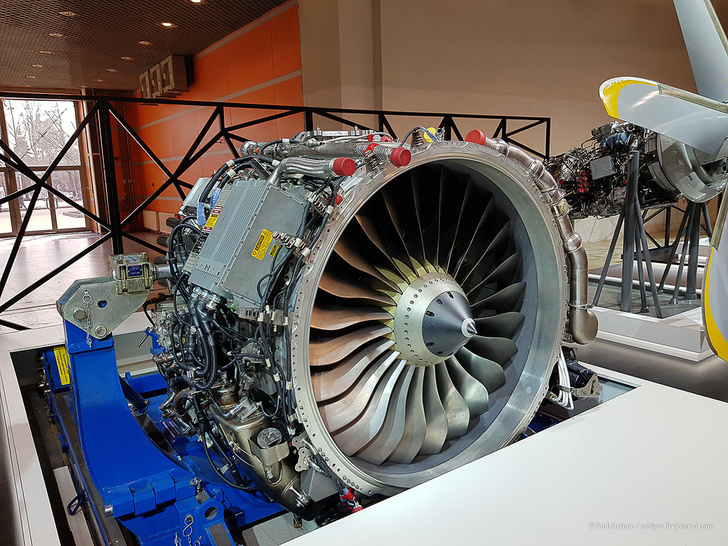
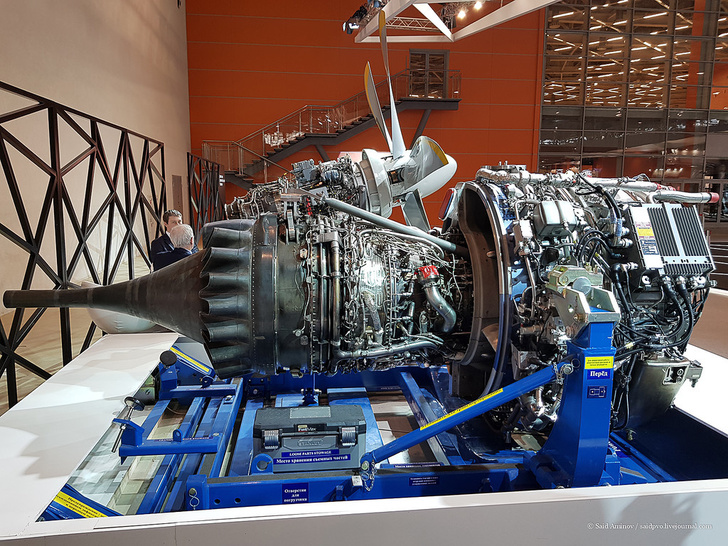
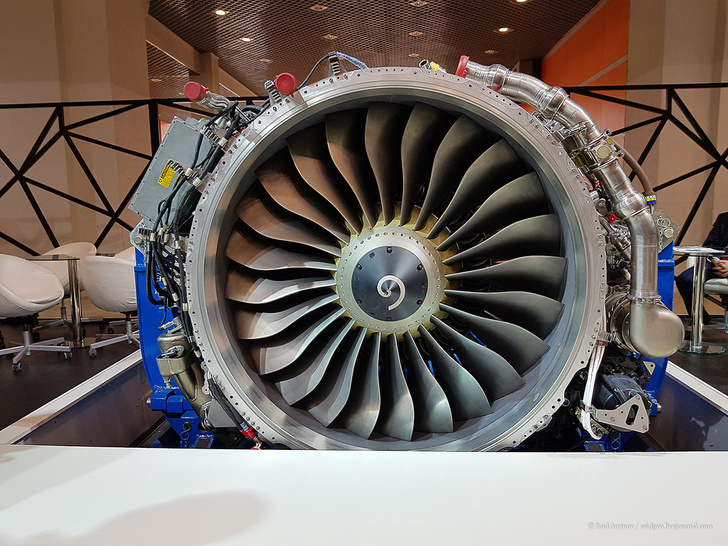
2 )
For the first time at the exhibition, the UDK demonstrated the full-scale sample of the turboprop engine TV7-117ST, developed by the St. Petersburg JSC "ODK-Klimov" and intended for equipping the regional IL-114-300 airliner and IL-112V light military transport aircraft. ground tests, for which in 2016 a test stand was created at JSC "ODK-Klimov", the capabilities of which allow testing the power plant at once with the propeller, nacelle and other elements of the aircraft (parts of the wing and fuselage). The use of a unified engine on IL-112 B and IL-114-300 aircraft will help reduce costs in production and will be an example of the transfer of military technology to the civilian sector. Resource tests of the TV7-117ST engine continue. In 2018, the advanced flight tests of TV7-117VST will continue as part of the IL-76LL flying laboratory. Produced by JSC "ODK-Klimov" in cooperation with other enterprises of the JDC.
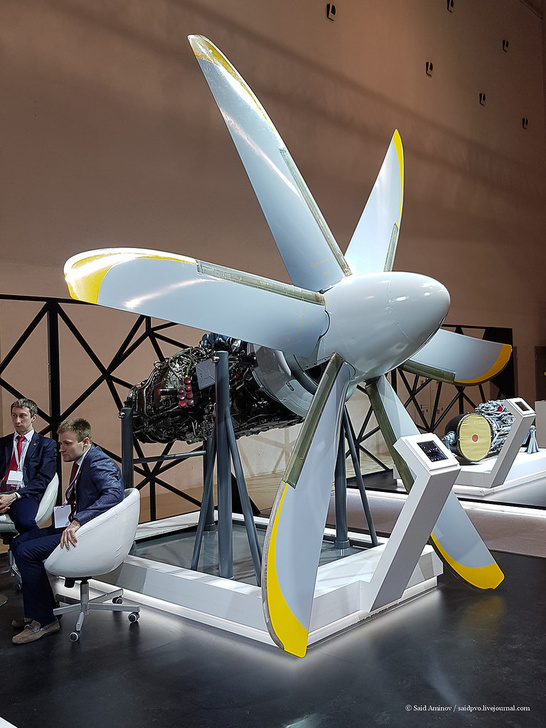
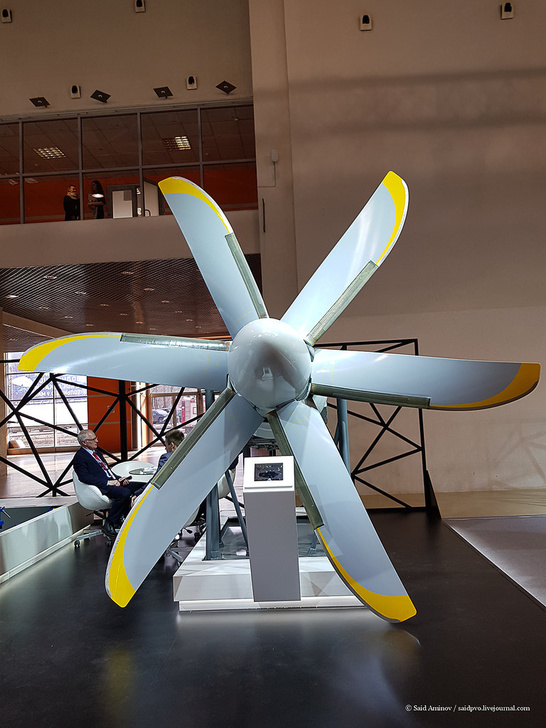
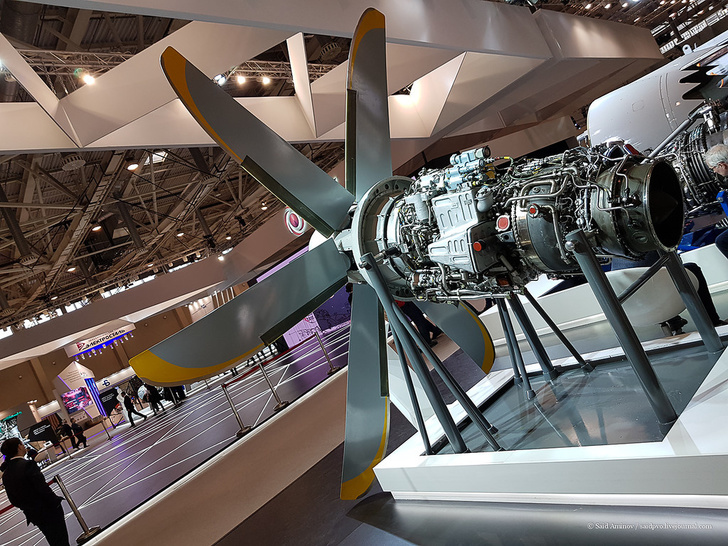
3 )
JSC "ODK-Klimov" developed and successfully tested the latest modification of the VK-2500 helicopter turbo-engine - VK-2500PS engine with improved performance characteristics and the use of modern Russian digital electronic control and monitoring system. The engine implements solutions that allow managing the resource characteristics depending on the specific operating conditions. The basic application of VK-2500PS is the newest civil Mi-171A2 helicopter. Earlier, the UDK provided the VK-2500 engine for production in Russia. Today, the UDK is increasing the pace of production of VK-2500 engines taking into account the needs of the state customer, as well as export supplies. The assembly is carried out from the Russian components.
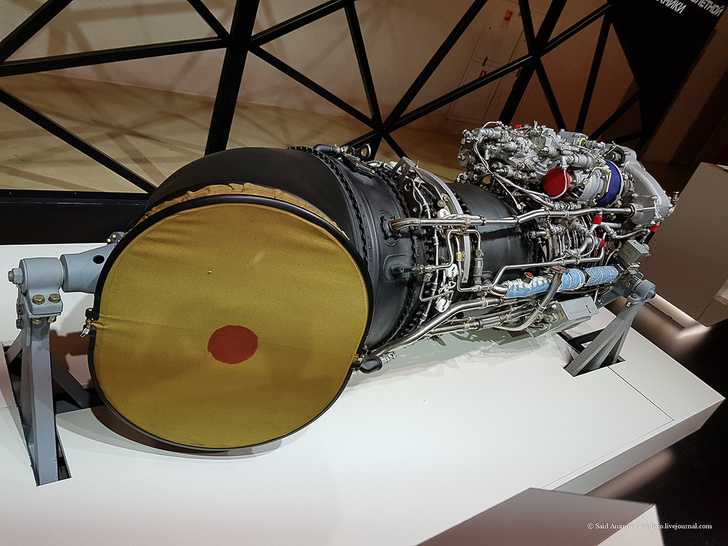
4 )
PD-14 is the basic turbofan engine, which is created in the wide cooperation of the enterprises of the UDC for the MS-21-300 airliner with the use of the newest technologies and materials, including composite ones. It is not inferior to foreign analogues in operation, but in many respects, in particular, emissions into the atmosphere, noise , etc., surpasses them. The UDK continues the flight and ground tests of the PD-14 engine, during which it confirms the declared parameters. The procedure for certification of the PD-14 basic engine both for Russian and international standards is in accordance with the established deadlines. In 2018, it is planned to receive a certificate of the Federal Air Transport Agency, and in 2019 - EASA. The main executor of the PD-14 program is JSC "ODK", the lead developer is JSC "ODK-Aviadvigatel", the parent manufacturer - JSC "ODK-Perm Motors"
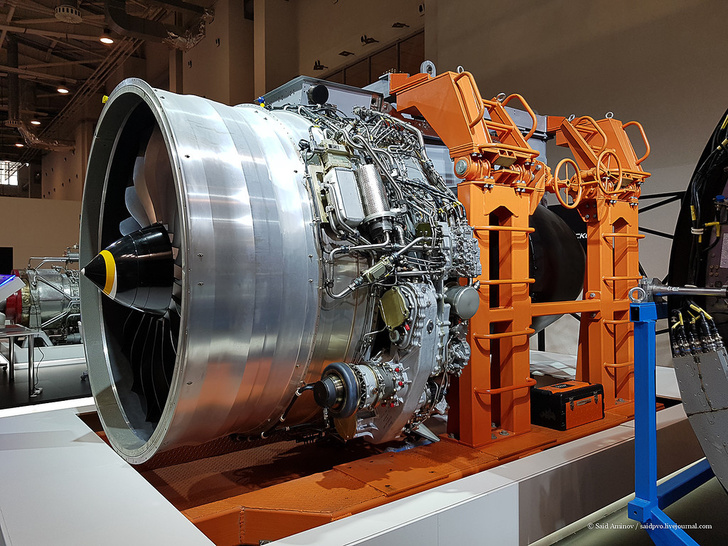
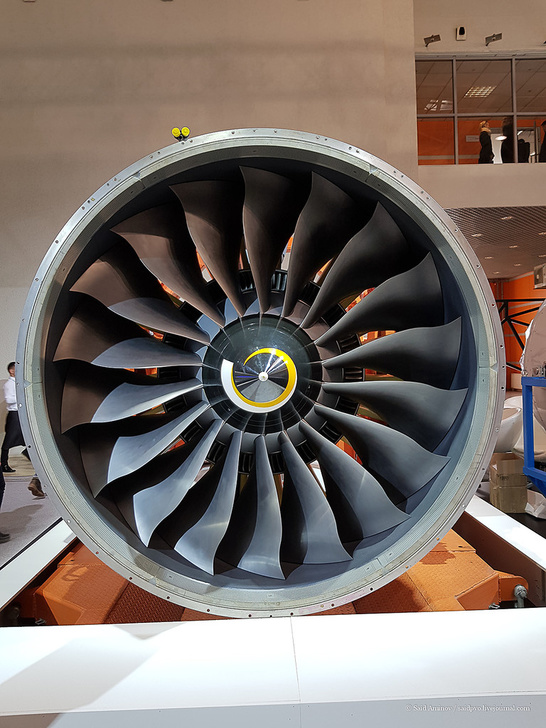
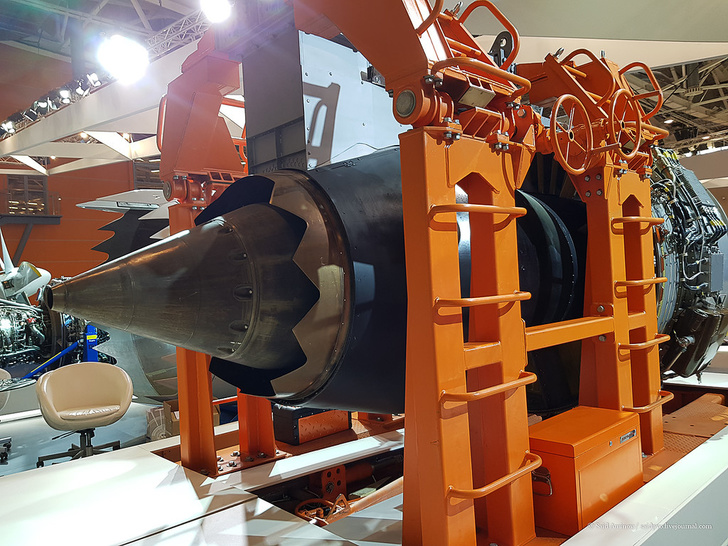
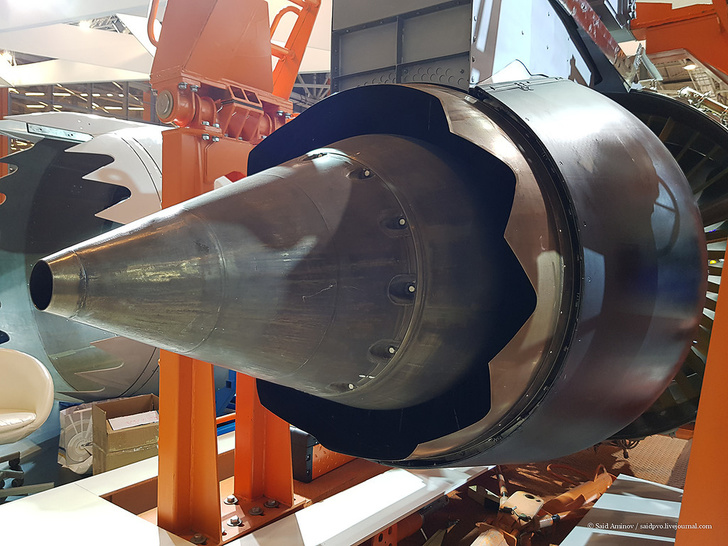
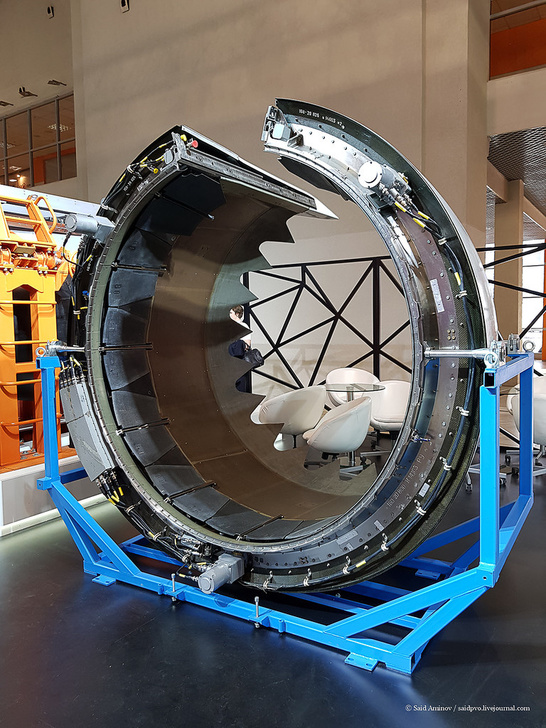
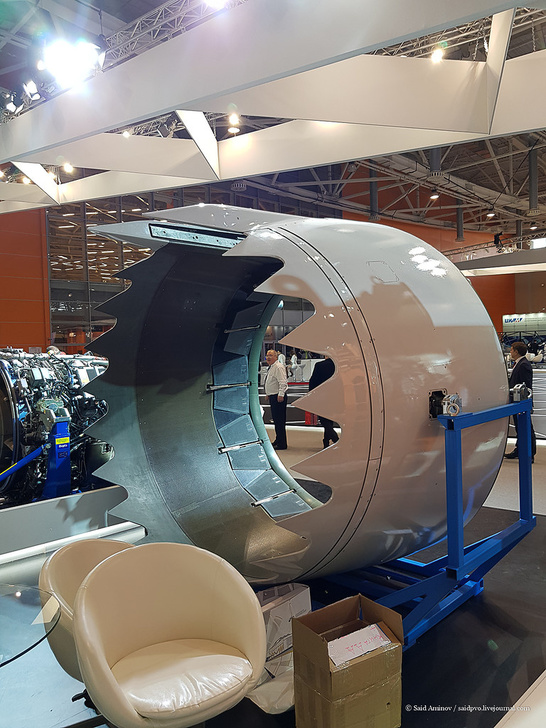
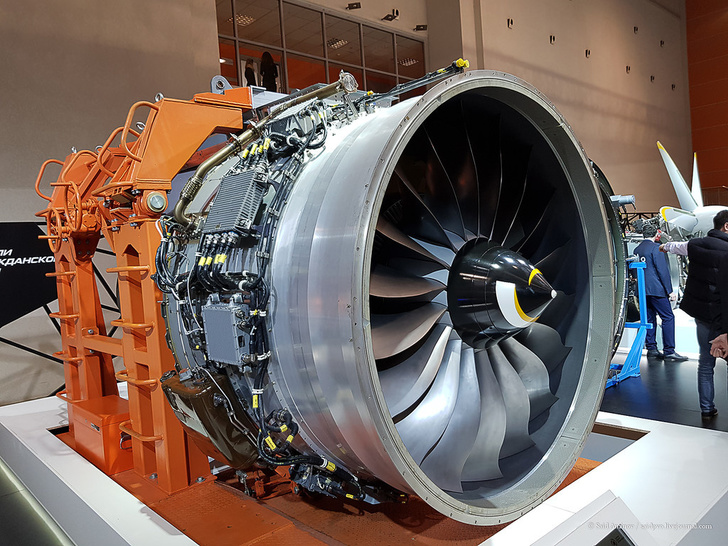
5 )
The liquid rocket engine NK-33 was created by the legendary Soviet designer Nikolai Kuznetsov for the "lunar" space project N1. It became the first in the world in its class - an engine, made in a closed circuit, working on oxygen-kerosene components, which has a multi-launch and repeated use. The development and production of the Samara enterprise ODK PJSC "Kuznetsov" presented at the forum of NK-33A is distinguished by reliability and perfection of technical parameters, demonstrates the maximum ratio of thrust to mass among modern engines. March 29, 2018 engine NK-33A, ensured the successful launch of a light carrier rocket Soyuz-2-1v from the military cosmodrome Plesetsk (Arkhangelsk region).
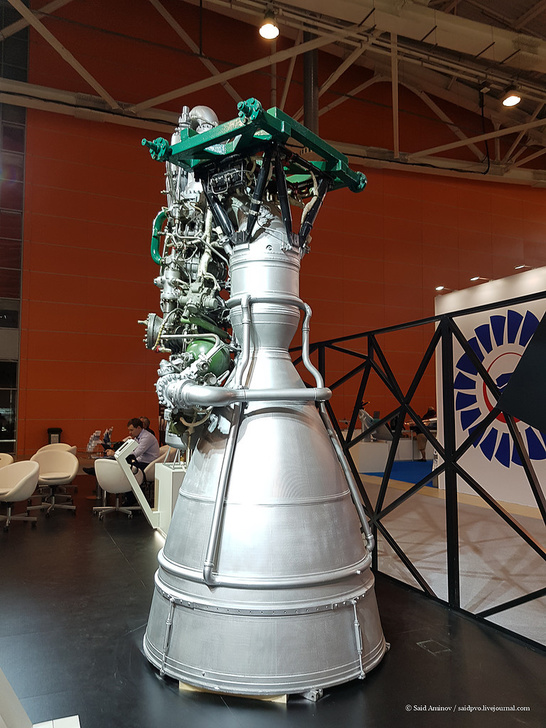
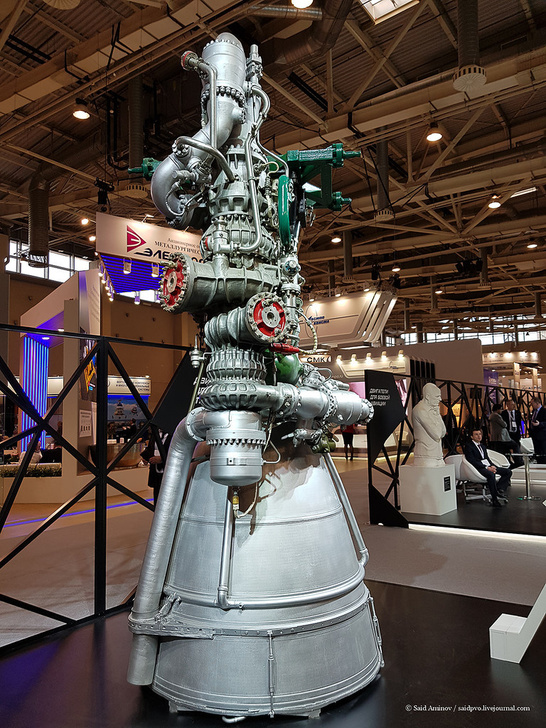
6 )
The engine TRDD-50AT (36MT) is designed for installation on unmanned aerial vehicles for special purposes. The main requirements for such GTE are the minimum dimensions and weight, high efficiency and reliability. UDC on the basis of PJSC "ODK-Saturn" had previously successfully implemented the import substitution program for small-sized engines.
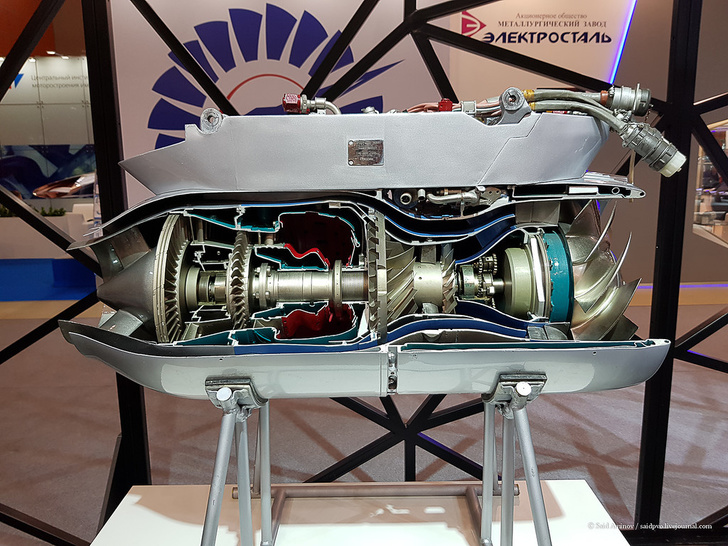
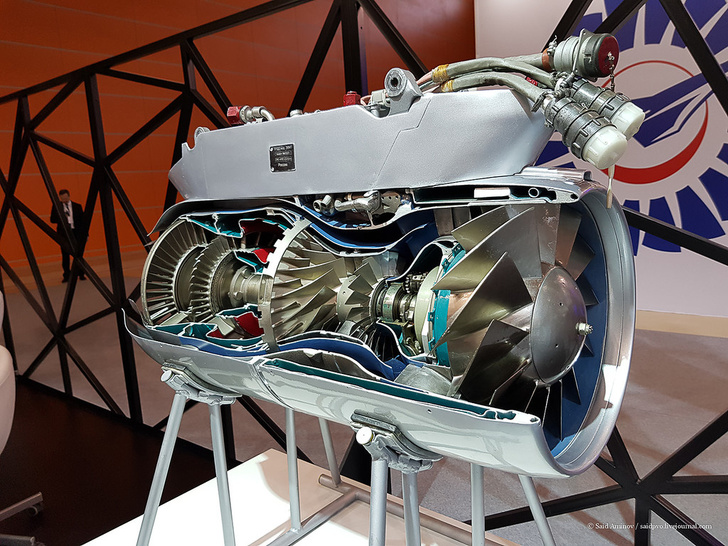
7 )
AL-41F-1C produced by the Ufa-based PJSC "UDK-UMPO", it is a turbojet two-loop engine of the 4+ generation with an afterburner and a controlled thrust vector, a deep modernization of the AL-31F engine. From the predecessor, the engine is distinguished by an increased life and a thrust of 14.5 tons. AL-41F-1C allows the aircraft to develop supersonic speed without the use of afterburner.
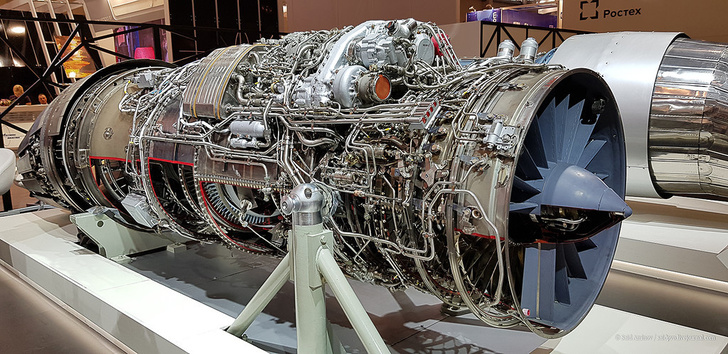
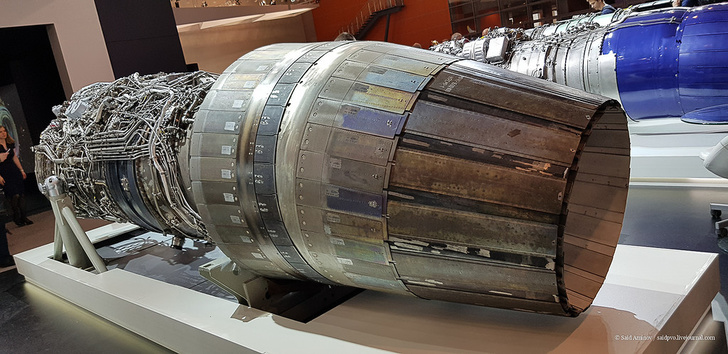
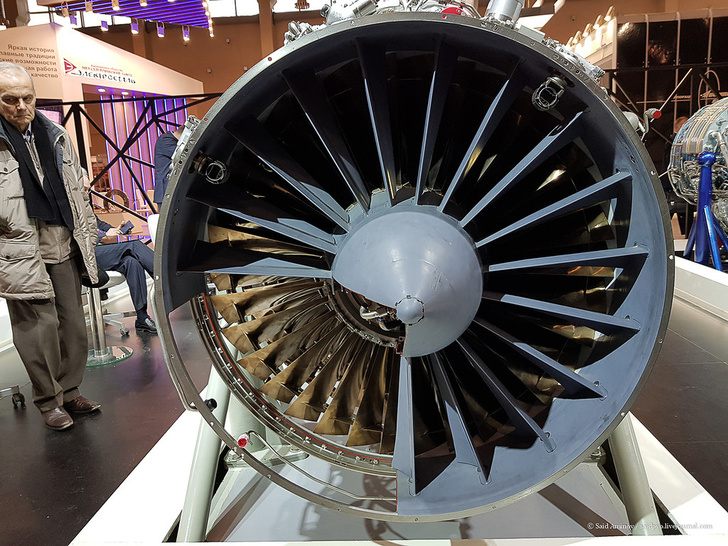
8 )
RD-33MK - turbojet dual-loop engine with afterburner - modification of the basic engine RD-33, subjected to serious design refinement. Designed for the MiG-29K / KUB deck fighter aircraft, as well as for the newest multi-purpose MiG-35 fighter. In January 2017 engines RD-33MK worked without any comments during the first test flight MiG-35. When creating the RD-33MK, all the advantages of the base platform were retained, while the engine has increased traction (in the forced modes it is increased to 10%). The engine is equipped with a modern digital automatic control and monitoring system BARK-42. The resource is significantly increased due to the application of the modernized turbine cooling system. The developer is JSC "ODK-Klimov", manufacturer - JSC "MMP named after V.V. Chernyshev "(Moscow).
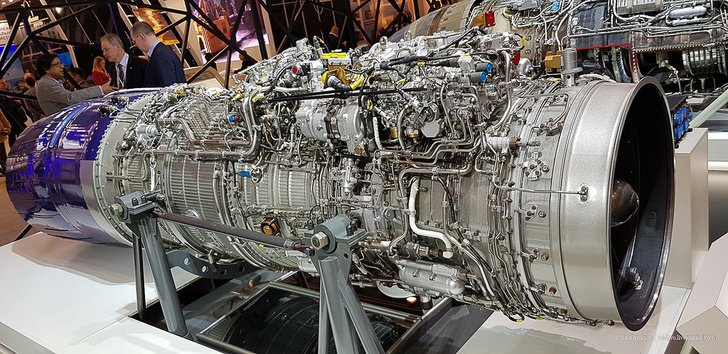
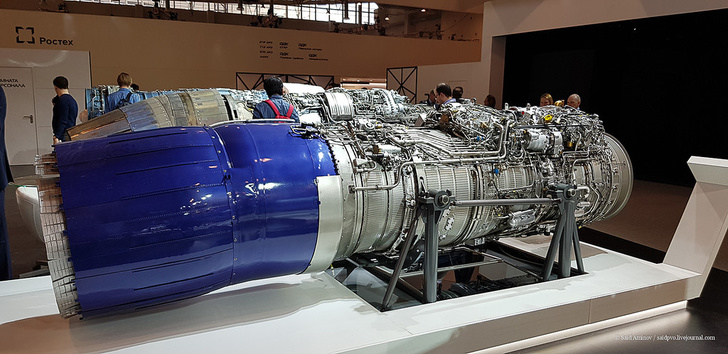
9 )
In 2015, the UDC completed the measures for import replacement of engine parts and engine components AI-222-25, which are equipped with Yak-130 combat training aircraft. Currently, it is manufactured by the Moscow NPC of gas turbine construction "Salyut" entirely from Russian components. Earlier, about half of the components were supplied from abroad.
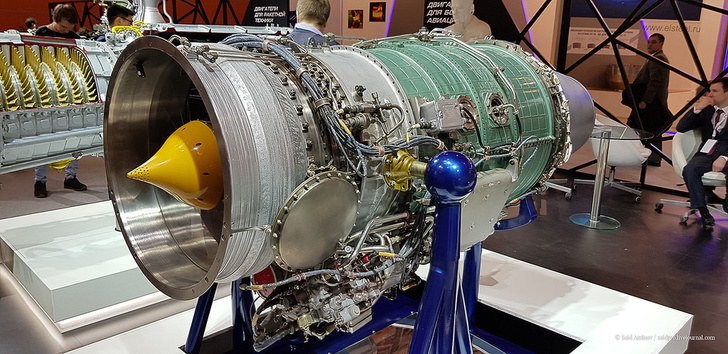
10 )
Floating model of the first domestic jet engine TR-1, developed under the leadership of A.M. Cradles
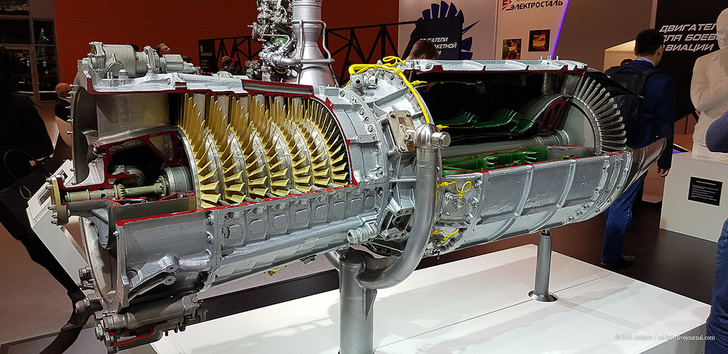

11 )
AL-31FN - turbojet two-circuit, two-shaft engine with mixing of internal and external contours behind the turbine, afterburner and all-variable adjustable supersonic jet nozzle. It is a modification of the AL-31F engine with the lower location of the boxes of engine and aircraft units. Designed for single-engine fighter aircraft manufactured in China. At MFD-2018 is presented a variant with a jet nozzle with a controlled thrust vector. This nozzle developed by the Moscow JSC "NPC gas turbine construction" Salyut "is an additional option for the engine, which allows to significantly improve the flight performance of the aircraft.
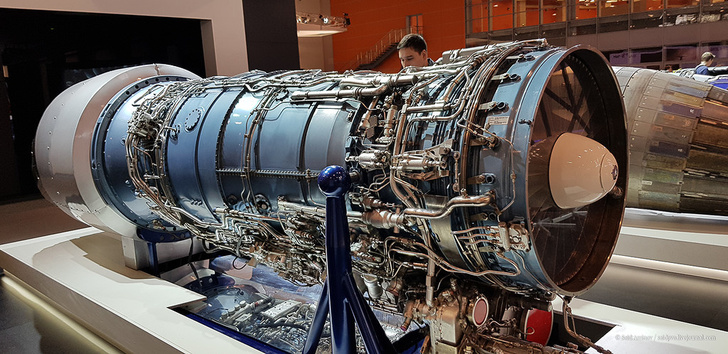
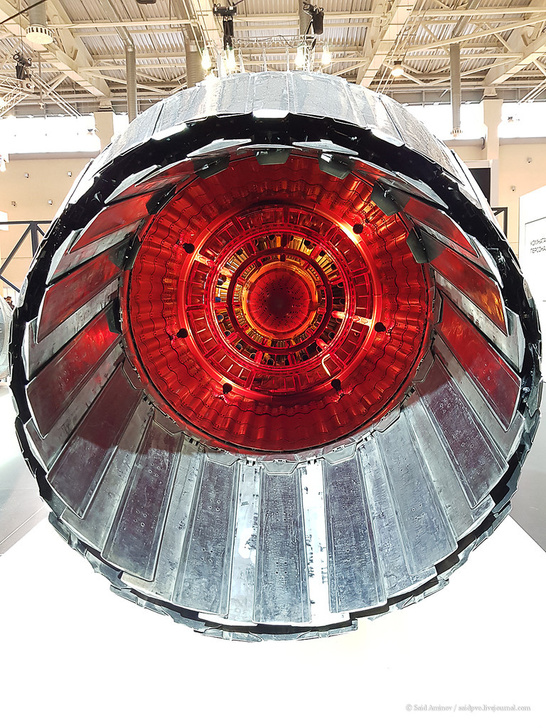
12 )
Ural Civil Aviation Plant (UZGA) will produce VK-800S engines intended for use as part of a twin-engine propulsion system on L-410UVP-E20 turboprops, as well as in power units of other light aircraft. The development of the project within the import substitution program is carried out by a separate subdivision of the enterprise in St. Petersburg. The customer is Minpromtorg of Russia.
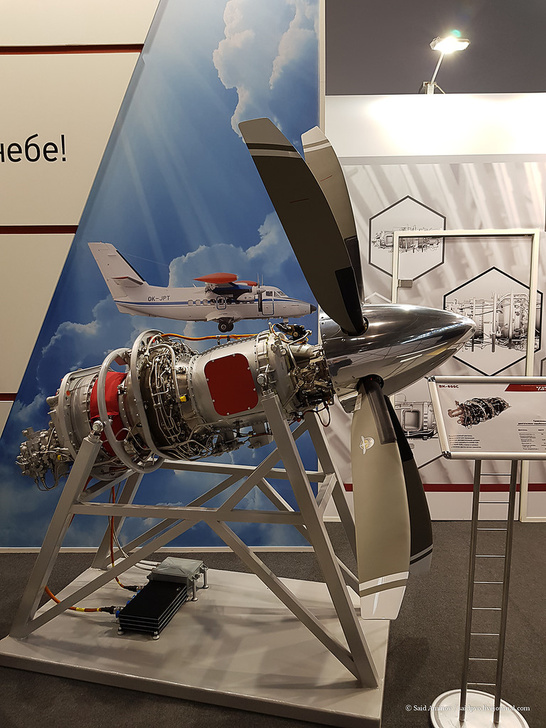
13 )
The input module of a high-speed fuel-gas-fueled hydrogen-fueled fuel test at the CIAM stand
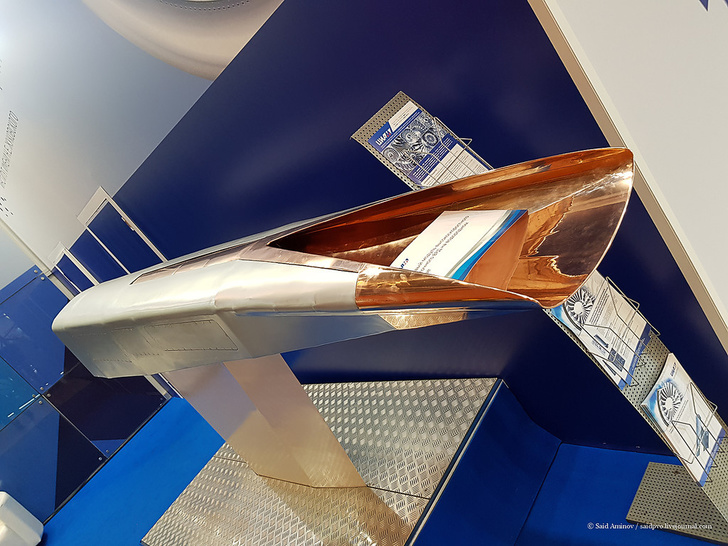
1 )
The civil aircraft engine industry was represented by the SaM146 powerplant, which is equipped with Sukhoi Superjet 100 (SSJ100) airliners. It is produced by Rybinsk PJSC "ODK-Saturn" on terms of equal partnership with Safran Aircraft Engines (France). The SaM146 engine is certified according to EASA and AR MAC standards and since 2011 is in commercial operation. The total operating time of the operating SaM146 powerplants in March 2018 exceeded 830,000 flight hours



2 )
For the first time at the exhibition, the UDK demonstrated the full-scale sample of the turboprop engine TV7-117ST, developed by the St. Petersburg JSC "ODK-Klimov" and intended for equipping the regional IL-114-300 airliner and IL-112V light military transport aircraft. ground tests, for which in 2016 a test stand was created at JSC "ODK-Klimov", the capabilities of which allow testing the power plant at once with the propeller, nacelle and other elements of the aircraft (parts of the wing and fuselage). The use of a unified engine on IL-112 B and IL-114-300 aircraft will help reduce costs in production and will be an example of the transfer of military technology to the civilian sector. Resource tests of the TV7-117ST engine continue. In 2018, the advanced flight tests of TV7-117VST will continue as part of the IL-76LL flying laboratory. Produced by JSC "ODK-Klimov" in cooperation with other enterprises of the JDC.



3 )
JSC "ODK-Klimov" developed and successfully tested the latest modification of the VK-2500 helicopter turbo-engine - VK-2500PS engine with improved performance characteristics and the use of modern Russian digital electronic control and monitoring system. The engine implements solutions that allow managing the resource characteristics depending on the specific operating conditions. The basic application of VK-2500PS is the newest civil Mi-171A2 helicopter. Earlier, the UDK provided the VK-2500 engine for production in Russia. Today, the UDK is increasing the pace of production of VK-2500 engines taking into account the needs of the state customer, as well as export supplies. The assembly is carried out from the Russian components.

4 )
PD-14 is the basic turbofan engine, which is created in the wide cooperation of the enterprises of the UDC for the MS-21-300 airliner with the use of the newest technologies and materials, including composite ones. It is not inferior to foreign analogues in operation, but in many respects, in particular, emissions into the atmosphere, noise , etc., surpasses them. The UDK continues the flight and ground tests of the PD-14 engine, during which it confirms the declared parameters. The procedure for certification of the PD-14 basic engine both for Russian and international standards is in accordance with the established deadlines. In 2018, it is planned to receive a certificate of the Federal Air Transport Agency, and in 2019 - EASA. The main executor of the PD-14 program is JSC "ODK", the lead developer is JSC "ODK-Aviadvigatel", the parent manufacturer - JSC "ODK-Perm Motors"







5 )
The liquid rocket engine NK-33 was created by the legendary Soviet designer Nikolai Kuznetsov for the "lunar" space project N1. It became the first in the world in its class - an engine, made in a closed circuit, working on oxygen-kerosene components, which has a multi-launch and repeated use. The development and production of the Samara enterprise ODK PJSC "Kuznetsov" presented at the forum of NK-33A is distinguished by reliability and perfection of technical parameters, demonstrates the maximum ratio of thrust to mass among modern engines. March 29, 2018 engine NK-33A, ensured the successful launch of a light carrier rocket Soyuz-2-1v from the military cosmodrome Plesetsk (Arkhangelsk region).


6 )
The engine TRDD-50AT (36MT) is designed for installation on unmanned aerial vehicles for special purposes. The main requirements for such GTE are the minimum dimensions and weight, high efficiency and reliability. UDC on the basis of PJSC "ODK-Saturn" had previously successfully implemented the import substitution program for small-sized engines.


7 )
AL-41F-1C produced by the Ufa-based PJSC "UDK-UMPO", it is a turbojet two-loop engine of the 4+ generation with an afterburner and a controlled thrust vector, a deep modernization of the AL-31F engine. From the predecessor, the engine is distinguished by an increased life and a thrust of 14.5 tons. AL-41F-1C allows the aircraft to develop supersonic speed without the use of afterburner.



8 )
RD-33MK - turbojet dual-loop engine with afterburner - modification of the basic engine RD-33, subjected to serious design refinement. Designed for the MiG-29K / KUB deck fighter aircraft, as well as for the newest multi-purpose MiG-35 fighter. In January 2017 engines RD-33MK worked without any comments during the first test flight MiG-35. When creating the RD-33MK, all the advantages of the base platform were retained, while the engine has increased traction (in the forced modes it is increased to 10%). The engine is equipped with a modern digital automatic control and monitoring system BARK-42. The resource is significantly increased due to the application of the modernized turbine cooling system. The developer is JSC "ODK-Klimov", manufacturer - JSC "MMP named after V.V. Chernyshev "(Moscow).


9 )
In 2015, the UDC completed the measures for import replacement of engine parts and engine components AI-222-25, which are equipped with Yak-130 combat training aircraft. Currently, it is manufactured by the Moscow NPC of gas turbine construction "Salyut" entirely from Russian components. Earlier, about half of the components were supplied from abroad.

10 )
Floating model of the first domestic jet engine TR-1, developed under the leadership of A.M. Cradles


11 )
AL-31FN - turbojet two-circuit, two-shaft engine with mixing of internal and external contours behind the turbine, afterburner and all-variable adjustable supersonic jet nozzle. It is a modification of the AL-31F engine with the lower location of the boxes of engine and aircraft units. Designed for single-engine fighter aircraft manufactured in China. At MFD-2018 is presented a variant with a jet nozzle with a controlled thrust vector. This nozzle developed by the Moscow JSC "NPC gas turbine construction" Salyut "is an additional option for the engine, which allows to significantly improve the flight performance of the aircraft.


12 )
Ural Civil Aviation Plant (UZGA) will produce VK-800S engines intended for use as part of a twin-engine propulsion system on L-410UVP-E20 turboprops, as well as in power units of other light aircraft. The development of the project within the import substitution program is carried out by a separate subdivision of the enterprise in St. Petersburg. The customer is Minpromtorg of Russia.

13 )
The input module of a high-speed fuel-gas-fueled hydrogen-fueled fuel test at the CIAM stand


kvs- Posts : 15821
Points : 15956
Join date : 2014-09-11
Location : Turdope's Kanada
- Post n°44
 Re: U.E.C.- Russian aircraft engines
Re: U.E.C.- Russian aircraft engines
The import substitution is mentioned in passing but is really rather profound. It means that Russia has a very deep
technological capacity and pre-existing intellectual resources. One just does not bootstrap component replacement
for jet engines from scratch and get results in a few months.
All those sanctions are a wonderful stimulus for Russia to further develop its technological diversity and thus
create synergistic potential.
technological capacity and pre-existing intellectual resources. One just does not bootstrap component replacement
for jet engines from scratch and get results in a few months.
All those sanctions are a wonderful stimulus for Russia to further develop its technological diversity and thus
create synergistic potential.
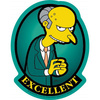
Hole- Posts : 11099
Points : 11077
Join date : 2018-03-24
Age : 48
Location : Scholzistan
- Post n°45
 Re: U.E.C.- Russian aircraft engines
Re: U.E.C.- Russian aircraft engines
Absolutely right. But it will take time. In 2020 we all will see the effects.

Austin- Posts : 7617
Points : 8014
Join date : 2010-05-08
Location : India
- Post n°46
 Re: U.E.C.- Russian aircraft engines
Re: U.E.C.- Russian aircraft engines
Gives a good comparision of VK-800S with others for indiginous engine L-410 turboprops , VK-800 seems to better compared to current american engine in use
Let L-410 turboprops to get Russian engines
http://www.rusaviainsider.com/l-410-turboprops-get-russian-engine/
Let L-410 turboprops to get Russian engines
http://www.rusaviainsider.com/l-410-turboprops-get-russian-engine/

Austin- Posts : 7617
Points : 8014
Join date : 2010-05-08
Location : India
- Post n°47
 Re: U.E.C.- Russian aircraft engines
Re: U.E.C.- Russian aircraft engines
Russia’s United Engine Corporation to develop high-power turboshaft
http://www.rusaviainsider.com/uec-develop-high-power-turboshaft/
http://www.rusaviainsider.com/uec-develop-high-power-turboshaft/
Russian United Engine Corporation will develop high-power turboshaft engine for future helicopters. Alexander Vatagin, the chief operating officer of its subsidiary Klimov, said at the International Engine Forum 2018 in Moscow last week that the program is currently at the research phase. It is scheduled to complete in 2019. The target thrust is 6,000 h.p., but more specific performance targets are still being coordinated with the customer – Russian Helicopters.
The engine demonstrator is expected to be assembled by 2021, and the development process is scheduled to complete in 2025. The designers claim that they are implementing the latest technologies, tried with UEC latest products, PD-14 and VK-2500M power plants, as well as additive technologies, 3D-printing and innovative materials, including mon-metals.
UEC -Klimov did not specify the type of the helicopter, for which the engine is intended.
As of today, there is no helicopter produced in Russia for that thrust range. Heavy helicopters, such as Mi-38 ate powered by TV7-117V rated at 2,800 hp at take-off. Super-heavy Mi-26T uses Ukrainian-made D-136 with 11,400 h.p. of thrust.

George1- Posts : 18497
Points : 19000
Join date : 2011-12-22
Location : Greece
- Post n°48
 Re: U.E.C.- Russian aircraft engines
Re: U.E.C.- Russian aircraft engines
Engine AL-31FN series 4 for China?
According to the publication "Air & Cosmos" in the material "Saliout propose la poussee vectorielle pour les J-10 chinois", a new modification of the Russian engine AL-31FN series 4 can be installed on Chinese J-10 fighters.
During the International Engine-Building Forum MDF-2018, which was held in Moscow on April 4-6, 2018, United Engine-Building Corporation JSC (UDK) presented the AL-31FN engine with a deflected thrust vector (OVT) developed at JSC Scientific Production Center gas turbine construction "Salyut". The engine is offered to China for new modifications of the J-10 fighter.

https://bmpd.livejournal.com/3157091.html
According to the publication "Air & Cosmos" in the material "Saliout propose la poussee vectorielle pour les J-10 chinois", a new modification of the Russian engine AL-31FN series 4 can be installed on Chinese J-10 fighters.
During the International Engine-Building Forum MDF-2018, which was held in Moscow on April 4-6, 2018, United Engine-Building Corporation JSC (UDK) presented the AL-31FN engine with a deflected thrust vector (OVT) developed at JSC Scientific Production Center gas turbine construction "Salyut". The engine is offered to China for new modifications of the J-10 fighter.

https://bmpd.livejournal.com/3157091.html

George1- Posts : 18497
Points : 19000
Join date : 2011-12-22
Location : Greece
- Post n°49
 Re: U.E.C.- Russian aircraft engines
Re: U.E.C.- Russian aircraft engines
The state bench tests of the AL-41F-1 engine have been completed
As reported in the press release of United Engine-Building Corporation JSC, the final meeting of the State Commission for the turbojet engine AL-41F-1 concluded with the solemn presentation of the PJSC "UDK-UMPO" (part of the United Engine Corporation of Rostekh) to complete the state bench tests an experienced engine. The ceremony was held in the Moscow branch of the enterprise - the Experimental Design Bureau. A. Lyulka.

Chairman of the State Commission Colonel VA. Bruskov handed over to the general designer-director of the OKB im. A. Lyulki E.Yu. Marchukov the document testifying to the end of the most important stage in the development of AL-41F-1.
Thus, 14-year experimental design work is completed. The AL-41F-1 performs the function of the first stage engine for the fifth-generation fighter Su-57 (PAK FA). The first test flight of PAK FA with AL-41F-1 took place on January 29, 2010.
https://bmpd.livejournal.com/3162157.html
As reported in the press release of United Engine-Building Corporation JSC, the final meeting of the State Commission for the turbojet engine AL-41F-1 concluded with the solemn presentation of the PJSC "UDK-UMPO" (part of the United Engine Corporation of Rostekh) to complete the state bench tests an experienced engine. The ceremony was held in the Moscow branch of the enterprise - the Experimental Design Bureau. A. Lyulka.

Chairman of the State Commission Colonel VA. Bruskov handed over to the general designer-director of the OKB im. A. Lyulki E.Yu. Marchukov the document testifying to the end of the most important stage in the development of AL-41F-1.
Thus, 14-year experimental design work is completed. The AL-41F-1 performs the function of the first stage engine for the fifth-generation fighter Su-57 (PAK FA). The first test flight of PAK FA with AL-41F-1 took place on January 29, 2010.
https://bmpd.livejournal.com/3162157.html

George1- Posts : 18497
Points : 19000
Join date : 2011-12-22
Location : Greece
- Post n°50
 Re: U.E.C.- Russian aircraft engines
Re: U.E.C.- Russian aircraft engines
Agreement on the development of the SaM146 engine option for the Be-200 amphibious aircraft
As reported on May 25, 2018, JSC United Engine Building Corporation (UDK), PJSC "ODK-Saturn" (part of the "United Engine Corporation Corporation" State Corporation Rostekh) and the French company Safran Aircraft Engines (part of the group Safran), within the framework Petersburg International Economic Forum concluded a framework agreement on the development of a modification of the SaM146 engine for the remotorized version of the Russian Be-200 amphibious aircraft.
https://bmpd.livejournal.com/3215030.html
As reported on May 25, 2018, JSC United Engine Building Corporation (UDK), PJSC "ODK-Saturn" (part of the "United Engine Corporation Corporation" State Corporation Rostekh) and the French company Safran Aircraft Engines (part of the group Safran), within the framework Petersburg International Economic Forum concluded a framework agreement on the development of a modification of the SaM146 engine for the remotorized version of the Russian Be-200 amphibious aircraft.
https://bmpd.livejournal.com/3215030.html



 kvs
kvs